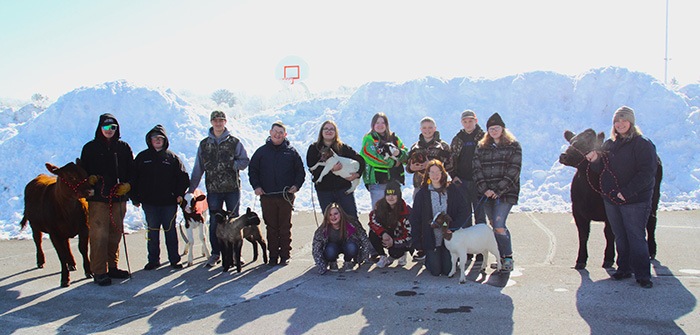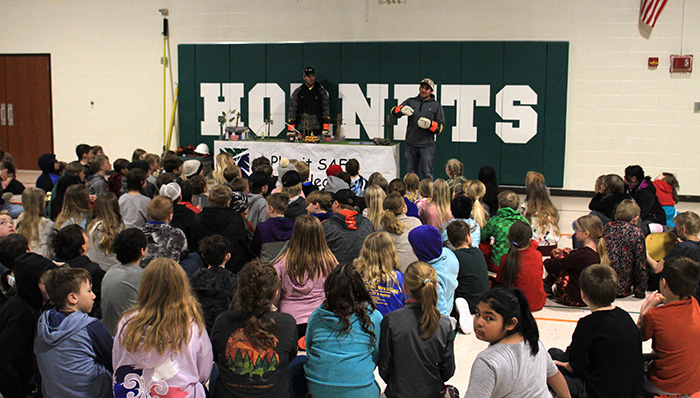Ag in the Classroom Day held in Frazee
News | Published on March 28, 2023 at 7:50pm EDT | Author: Chad Koenen
0
Above: Ag in the Classroom Day at Frazee-Vergas Elementary School included a presentation on electricity safety by employees of Lake Region Electric Cooperative Thursday, March 23. Below: Ag instructor and FFA Advisor Trescha Mitchell, right, and her students were showing animals to elementary kids as part of Ag in the Classroom Day Thursday, March 23.
Teacher, students talk ag education needs at school
By Robert Willams
Editor
This year’s 31st annual Ag in the Classroom Day at Frazee-Vergas Elementary School had a more impactful feel with the growing need at the high school for more agricultural and technology-based instructors.
At the March school board meeting, the board approved a 0.5 position increase to create an opening for a second full-time ag instructor position the district is currently attempting to fill. That could prove to be a difficult task.
A shortage of ag teachers both regionally and nationwide has been an issue for schools and universities in Minnesota and North Dakota dating back to 2010.
Frazee-Vergas currently has one ag instructor and FFA advisor in Trescha Mitchell, who has taught in the district the past four years. Social Studies teacher Jim Rader is the current 0.5 instructor fitting in work-based learning and a basic woods class into his schedule.
The in-district demand was increased in large part due to the retirements of business teacher Brian Tangen and former ag instructor and FFA advisor Doug Schwarzrock in 2022. The loss of Andrew Paulson also affected the department when he took an Information Technology position at Perham Public Schools in 2021.

For both Mitchell and her students, filling that full-time ag opening is a big priority.
“I think it is really important because we do have such a largely-based ag area and community,” said junior Linsey Marks. “It’s important for kids to understand where ag would be important and to have those people with those leadership qualities give an example of why we need ag. Why it’s so important. We get everything from ag and I feel it’s such an important thing. When we lose so many people; especially people who have been around for so long, it’s really hard to try and recover from that and still try to be able to teach people, hey, this is why we need it and this is what it is.”
Both the school board and district administrators have acknowledged the need publicly. It has been a hot topic at multiple board meetings this school year, led in large part by Becker County Commissioner Erica Jepson who has brought along groups of FFA students to express to the board how critical the need is. Jepson made those appearances, not as a county representative, but as a Frazee graduate and a parent. One of the students that she always brought along was her daughter Allison, a senior at Frazee.
Allison knows first-hand the effects of the missing full team of ag-based instructors on her education.
“We lost a lot of elective classes,” she said. “I’ve taken welding twice now, basic woods three or four times. It really limits what you can take so people are going to schools where they can take other ag classes or have other opportunities.”
Opportunities is the key word in this whole story. When talking to a group of FFA and ag students during Ag in the Classroom day, it was the first and most prominent word used by multiple members of the group.
In taking the same classes over, there are steps up from the first time, but it detracts from the fact that in Jepson’s case, she would much prefer to be learning something new rather than a slightly upgraded version of the class she already passed. It also has an adverse effect on the instructor trying to find a balance between first-timers and retakers.
“It’s hard,” said Mitchell. “From a teaching perspective, when you have a class full of 20+, almost 30 kids, and you have some of these kids that have retaken the classes. It can be really hard to sometimes make that balance but you want to challenge them. You don’t want them to lose additional skills. When you have kids at basic skills, and kids like Allison, who should be at advanced-plus skills, you’re really holding those kids back. We’re really not doing justice and what’s best for kids in our district and that’s what we need to be able to provide.”
Advanced instruction, along with the tech side of agriculture, are aspects of learning that the kids and Mitchell believe are critical to future students.
Mitchell noted the absence of education in ag business, ag mechanics and other basic training courses that are the stepping stones to higher-end jobs in the field.
“We’re really limiting the kids’ education,” Mitchell said. “We’re not adding on any engineering or robotics.”
For the district, finding the perfect candidate is a tall task. Schwarzrock, for example, taught at FHS for 38 years and covered both ag and science. Tangen taught for three decades and provided his own level of versatility.
In a feature story in the Forum last May, Schwarzrock said there was some serendipity and perfect timing in how initially he got the position. Perhaps, similar elements of chance might happen with a new candidate, but the odds are stacked.
For instance, the University of Minnesota-Crookston, an agriculture-based college since its inception, is graduating six students with agriculture instruction-related degrees this year, according to Mitchell.
For her part, Mitchell has provided input to the district and has been trying to sell the position to potential candidates at multiple colleges she has connections to, including ag programs in Crookston, at NDSU and SDSU, along with schools in the Twin Cities.
“We’ve got a great community; we’ve got great families, great kids and we just need to provide them with more education availability,” Mitchell said.
For Allison Jepson, she is interested in pursuing a degree in agriculture education, not just because there is a prominent need, but to impart the importance of the field.
“Yes and to teach people that ag is not just farming,” said Jepson. “There are so many aspects of agriculture that people don’t realize. Cutting lumber is an ag industry.”
“There are so many opportunities in agriculture that people don’t really understand,” said Mitchell. “It’s not just cows and plows. It’s engineering, agri-science, precision ag, think of the drones and all the technology that comes in. Times have changed and Frazee’s got to change in that direction to keep things going and provide kids that education.”
Being a part of the county’s Ag in the Classroom is one of the ways the ag and FFA students in Frazee can pass part of that education to the elementary kids.
“We’re doing ag in the classroom to educate these fourth graders,” said Mitchell. “So they hopefully have a better understanding. We’re very blessed that we have the Becker County Ag in the Classroom committee come in and help educate in the different areas we have going on today. Also, these FFA kids taking part and putting their input in with those different industries. If it’s mechanics or poultry industries, like the turkeys, the beef, the sheep, whatever direction it is. Plus, we have the live animals for kids to see too, and have that hands-on experience.”
Along with an array of different animals from goats to chickens, Brady Mitchell of Detroit Lakes was on hand with his show cows. Mitchell was awarded a South Devon heifer at last year’s Minnesota Beef Expo.
Getting up close with animals is one of the aspects of ag education that revolve around FFA’s three-circle model for organizing instruction.
That intercurricular instruction involves the relationships between three major concepts: classroom and laboratory instruction, supervised agricultural experience, and agricultural youth organization participation.
For instance, Jepson, who will be receiving her Minnesota FFA State degree later this year, along with classmate Jonathan Buhr, is a prime example of the integrated instruction.
In the past year outside of the classroom, she has attained supervised agricultural experience in goat and beef production, along with working at Mark’s Fleet Supply in Perham.
“That is where the three-circle comes all complete,” said Mitchell.
Elementary kids are a few years away from FFA membership. Students cannot join FFA until seventh grade in Frazee. As soon as a student takes an ag class they are automatically an FFA member. Marks, Jepson and Mitchell know the high school’s ag and tech departments can be places that hook kids.
“My biggest thing is I just want them to come through the doors of the agriculture department and the career tech education (CTE) department because once they get in it seems that’s where their interest comes,” said Mitchell.
Ag in the Classroom is predominantly about education. FFA does not use it as a recruiting tool.
“Yes and no,” said Marks. “With our dairy part of it, I know that they’re in there teaching kids what the cows are doing for you, where you get all your food and why farmers are so important. They’re kind of expressing FFA in a sense. This is how you can be involved and support these farmers.”
Given the demographics of the school’s student body, FFA, ag and CTE classes serve a wider proportion of kids than many schools in the region.
“It’s important because not many of the kids are going to go to college at our school,” said Jepson. “A lot of them don’t want to go to college, so our ag class helps them. They can learn how to weld so they can go to work at BTD, or learn woodworking.”
Mitchell has seen plenty of success stories from recent graduates.
“The biggest thing with career tech education, the two-year programs or the on-the-job training, I look at a lot of my past students and they’re making a heck of a lot more money than I am doing currently and I went to four-year college,” she said. “The opportunities are endless for these kids if they can learn the skills and hands-on working activities.”

